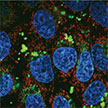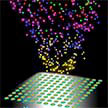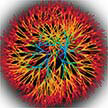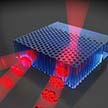Showing Spotlights 361 - 368 of 2779 in category All (newest first):
 By using rod-shaped nanoparticles, in combination with inhibitors to other uptake pathways, researchers achieved targeting cancer cells over healthy cells.
The possible benefits from this novel technique are twofold: Restricting healthy cells from taking anticancer drugs to help reduce the side effects of drugs for patients; and helping overcome chemoresistance (the uptake of the chemo drug into healthy cells in the tumor setting is one of the main causes of chemoresistance).
By using rod-shaped nanoparticles, in combination with inhibitors to other uptake pathways, researchers achieved targeting cancer cells over healthy cells.
The possible benefits from this novel technique are twofold: Restricting healthy cells from taking anticancer drugs to help reduce the side effects of drugs for patients; and helping overcome chemoresistance (the uptake of the chemo drug into healthy cells in the tumor setting is one of the main causes of chemoresistance).
Jun 10th, 2021
 Relying on the quantum confinement effect, the strong light-matter interaction in low-dimensional materials enables them to exhibit excellent photodetection. The unique out-of-plane van der Waals force in low-dimensional layered materials makes them free from the surface dangling bonds compared to traditional bulk materials, which reduces the dark current of the devices by eliminating surface recombination. These unique advantages make low-dimensional materials have the potential to achieve breakthroughs in the field of low-cost high-performance room-temperature infrared detection.
Relying on the quantum confinement effect, the strong light-matter interaction in low-dimensional materials enables them to exhibit excellent photodetection. The unique out-of-plane van der Waals force in low-dimensional layered materials makes them free from the surface dangling bonds compared to traditional bulk materials, which reduces the dark current of the devices by eliminating surface recombination. These unique advantages make low-dimensional materials have the potential to achieve breakthroughs in the field of low-cost high-performance room-temperature infrared detection.
Jun 7th, 2021
 With a new approach, that brings us closer to the commercial application of 3D color holograms, scientists have developed the concept of a virtual 3D color object consisting of colorful focal spots at discrete heights in the out-of-plane dimension above the surface of a print - something they dubbed 'optical fireworks'. Unlike previous 3D color holograms, this color-filtering microlens-based displays realize multicolor and multifocal simultaneously in the form of bright colorful focal spots floating above the prints.
With a new approach, that brings us closer to the commercial application of 3D color holograms, scientists have developed the concept of a virtual 3D color object consisting of colorful focal spots at discrete heights in the out-of-plane dimension above the surface of a print - something they dubbed 'optical fireworks'. Unlike previous 3D color holograms, this color-filtering microlens-based displays realize multicolor and multifocal simultaneously in the form of bright colorful focal spots floating above the prints.
Jun 2nd, 2021
 Nature has developed excellent biolubricating systems but onnce biolubrication for instance of synovial joints of osteoarthritis patients breaks down, relief has to come from partially or fully synthetic biolubricants - such as polymeric micro- or nanoparticle-based lubricants - that replace the depleted natural substances. Researchers have now demonstrated that phytoglycogen nanoparticles - single-molecule highly branched polysaccharides extracted from sweet corn kernels - are a highly effective biolubricating material.
Nature has developed excellent biolubricating systems but onnce biolubrication for instance of synovial joints of osteoarthritis patients breaks down, relief has to come from partially or fully synthetic biolubricants - such as polymeric micro- or nanoparticle-based lubricants - that replace the depleted natural substances. Researchers have now demonstrated that phytoglycogen nanoparticles - single-molecule highly branched polysaccharides extracted from sweet corn kernels - are a highly effective biolubricating material.
May 25th, 2021
 Nanotechnology is a promising technological advancement that can revolutionize agriculture and food production systems, but the technology must be thoroughly researched before being implemented. Nanobiosensors, nanofertilizers, and nanopesticides have the potential to significantly change the agricultural world. Nanotechnology research related to agriculture is still in its early stages, meaning these new products are not ready to be put on shelves. In particular, toxicity of nanoparticles is a serious concern because it can affect the plants, the soil, and the farmers.
Nanotechnology is a promising technological advancement that can revolutionize agriculture and food production systems, but the technology must be thoroughly researched before being implemented. Nanobiosensors, nanofertilizers, and nanopesticides have the potential to significantly change the agricultural world. Nanotechnology research related to agriculture is still in its early stages, meaning these new products are not ready to be put on shelves. In particular, toxicity of nanoparticles is a serious concern because it can affect the plants, the soil, and the farmers.
May 24th, 2021
 When experimental biomedical research results using only one sex are extrapolated to both sexes, unintended harmful consequences to the neglected sex can be the result. Nevertheless, it is still the case that only a small number of published articles report the sex of biosystems used in their study. Many researchers are still using only one sex of biosystems - e.g., cells, tissues, or animals - and apply the results to both males and females. And with the emergence of nanomedicine, the importance of sex in biomedical research has become even more obvious.
When experimental biomedical research results using only one sex are extrapolated to both sexes, unintended harmful consequences to the neglected sex can be the result. Nevertheless, it is still the case that only a small number of published articles report the sex of biosystems used in their study. Many researchers are still using only one sex of biosystems - e.g., cells, tissues, or animals - and apply the results to both males and females. And with the emergence of nanomedicine, the importance of sex in biomedical research has become even more obvious.
May 20th, 2021
 Inspired by the silk spinning of spiders, researchers have developed a facile strategy to artificially create natural, silk-like hierarchical fibers. They demonstrate the creation of biomimetic and highly bioactive materials by artificially manipulating the self-assembly of silk protein molecules. This work contributes to the understanding of the natural silk spinning process of spiders and provides a strategy for the design and development of advanced fibrous biomaterials for various applications.
Inspired by the silk spinning of spiders, researchers have developed a facile strategy to artificially create natural, silk-like hierarchical fibers. They demonstrate the creation of biomimetic and highly bioactive materials by artificially manipulating the self-assembly of silk protein molecules. This work contributes to the understanding of the natural silk spinning process of spiders and provides a strategy for the design and development of advanced fibrous biomaterials for various applications.
May 3rd, 2021
 The propagation of light can be radically controlled with tailor-made nanostructures, called photonic crystals. The main feature of such crystals is a forbidden gap: waves with colors within a forbidden range travel only a limited distance - called Bragg length - before being reflected due to Bragg interference. Scientists have discovered a method to tunably steer light deep into photonic crystals, to depths well beyond the Bragg length. By spatially shaping the incident waves, the energy density of the light is enhanced at tunable distances deep inside the crystals.
The propagation of light can be radically controlled with tailor-made nanostructures, called photonic crystals. The main feature of such crystals is a forbidden gap: waves with colors within a forbidden range travel only a limited distance - called Bragg length - before being reflected due to Bragg interference. Scientists have discovered a method to tunably steer light deep into photonic crystals, to depths well beyond the Bragg length. By spatially shaping the incident waves, the energy density of the light is enhanced at tunable distances deep inside the crystals.
Apr 22nd, 2021
 By using rod-shaped nanoparticles, in combination with inhibitors to other uptake pathways, researchers achieved targeting cancer cells over healthy cells.
The possible benefits from this novel technique are twofold: Restricting healthy cells from taking anticancer drugs to help reduce the side effects of drugs for patients; and helping overcome chemoresistance (the uptake of the chemo drug into healthy cells in the tumor setting is one of the main causes of chemoresistance).
By using rod-shaped nanoparticles, in combination with inhibitors to other uptake pathways, researchers achieved targeting cancer cells over healthy cells.
The possible benefits from this novel technique are twofold: Restricting healthy cells from taking anticancer drugs to help reduce the side effects of drugs for patients; and helping overcome chemoresistance (the uptake of the chemo drug into healthy cells in the tumor setting is one of the main causes of chemoresistance). 
 Subscribe to our Nanotechnology Spotlight feed
Subscribe to our Nanotechnology Spotlight feed





